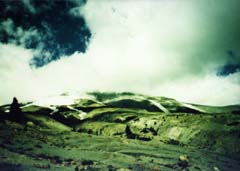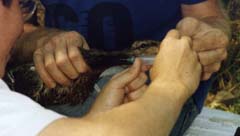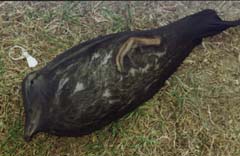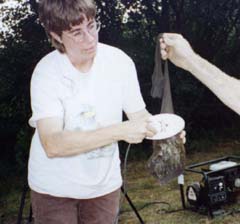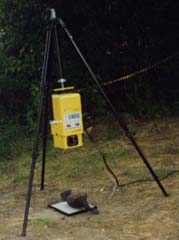That America did not follow the European trend is far more than just regrettable. We are still suffering the consequences of legal corporate policies that permitted them to dispose of the toxic residue from their chemical manufacturing plants while encased only in quickly-eroding metal drums. These drums were dumped into the oceans, lakes, and rivers, or shallow holes dug into the ground, and even municipal landfills. Some were just left sitting outdoors behind the manufacturing plants where weather processes rapidly disintegrated them (Piasecki 1). It's likely that there were yet other dubious historical methods of disposal that remain elusive, but what is certain is that they were all dangerous .
When did hazardous waste contamination become a recognizable problem?
It is difficult to specify exactly when hazardous waste contamination became a recognized
problem in America. Like many pertinent issues, it has fallen in and out of public
attention in the past, and on no occasion had enough immediate impact to necessitate the drastic governmental legislation needed to solve the problem. Two important
catalysts in the creation of federal hazardous waste laws were Rachel Carson and
the Nixon administration, but it was not until the public outcry of a suffering populace
in Niagara Falls, New York that any effective federal legislation was passed.
In 1962 the book "Silent Spring" was published by marine biologist Rachel Carson.
Her investigation into the dangers of pesticides and other chemicals was the first
of its kind to be brought into the public spotlight. "Silent Spring" sold over a
half-million copies upon initial publication and inspired an hour-long CBS report. Shortly thereafter,
president Kennedy held an investigation that validated Carson's findings. The result
was a ban on DDT and the formation of the first environmental government agencies (Gore ?).
Several years later in 1970, the Nixon administration formed the Environmental Protection
Agency, which was meant to have authority over all matters of pollution whether air,
water, or land-based. However, the EPA was primarily concerned with the more publicly-hyped problems of air and water pollution and it gave its Solid Waste Management
Program almost zero attention (Epstein 186). Despite the uncertainty of the federal
government's responsibilities in the area of hazardous waste, if it were not for
the Nixon administration's creation of the EPA the important legislation that protects
America today might not exist.
Unfortunately, neither the protection of the EPA or the earlier warnings by Carson
about hazardous chemicals were enough to secure the safety of America from more serious
land poisoning. It was the Love Canal disaster at Niagara Falls that finally brought
the American public to the breaking point. From 1942-1953 the Hooker Chemical Company
dumped 20,000 tons of hazardous waste into the canal, after which the property was
covered and sold to the Niagara Falls school district for a token dollar. A year
later the 99th Street School was built over it and a residential area soon followed (Matthews
1-3). Visible problems in the area were not immediately forthcoming, but by the mid
70's it was clearly too late for many residents. The rates for cancer, miscarriage,
and birth defects were all catastrophically high. People noticed strange odors in
their water and air. When they dug in their backyards the holes immediately gushed
with oily liquids that ranged in all colors and reeked of toxic fumes. Their basements
oozed with these same liquids. Children suffered from allergy-like symptoms in the school.
People broke out in rashes, pets went bald and trees lost their leaves in early March
(Brown 10, 16-17, 18-21). In order to appreciate the scope of the problem it is important to understand that the horrible conditions played out at Love Canal were repeated
all over the country, and that a great number of them were also the fault of the
Hooker Chemical Company. There were many other organizations also at fault however,
and one of these was the United States Army Chemical Corps itself.
By August 1978 the pressure waged by the Love Canal Homeowners Association had convinced
the governor of New York to announce that the state's Urban Development Corporation
would purchase approximately 240 of the homes on the streets nearest to the canal
(Brown 37). This did not however take care of the hundreds of other homes located farther
away from the canal that were nonetheless contaminated by dangerous benzene gas and
other chemicals. Dissatisfaction remained and in May of 1980 local residents of Love Canal had finally reached their limit. Nearly five years since the realization of
their troubles and fed up with the government's failure to respond to the situation,
they took two EPA officials hostage. They had the government's attention at last
and what soon followed was called the Comprehensive Environmental Response, Compensation,
and Liability Act of 1980 (CERCLA), better known as Superfund. It is still in effect
today.
Superfund Program
Administered by the Environmental Protection Agency (EPA), the Superfund Program's
main goal is to protect human health and the environment. Common hazardous waste
sites include abandoned warehouses, manufacturing facilities, processing plants and
landfills. Consequently some of these sites developed levels of contamination which posed
human health threats. Superfund established prohibitions and requirements for abandoned
hazardous waste sites, administers liability for the contamination, and created a
trust fund to provide for cleanup when the responsible persons cannot be identified.
(1)
"One out of four Americans lives within four miles of a hazardous waste site." (2)
Hazardous waste removal does not happen without extreme costs. When balancing health
and environmental values against monetary costs it becomes an issue of what is important to society. When established in 1980, Superfund was delegated $1.6 billion over
a five year period. In 1986, Superfund Amendments and Reauthorization act supplied
$8.5 billion for the program. (3) These dollar amounts can be overwhelming, but
when understanding the complexity of the selection and cleanup process suddenly the costs
seem more justified. Consider the Bunker Hill Mining and Metallurgical Site, which
will require approximately $90 million over a 30 year period. (4)
The Superfund Trust was established to remove the hazardous chemicals that pose human
health and environmental threats at selected Superfund sites. The funds are generated
mainly from taxes on the chemical and petroleum industry. The Trust Fund is primarily used when the EPA cannot identify the people responsible for the contamination.
When the EPA can identify the polluter, they will negotiate the cost for planning
and cleanup process. If the responsible parties refuse to pay, Superfund will pay
for the costs and then attempt to get the money back through legal action. (2)
For a hazardous wastes location to become a Superfund site several steps must take
place. The site first has to be discovered and then reported to the EPA. Next,
the site must be placed on EPA's computerized inventory, assessed of its hazards,
and ranked according to its possible effects. It is then listed on the National Priority List.
The site then goes through a remedial Investigation / feasibility study where a
decision is recorded, and finally remedial action is taken. The selection process
may take years to complete before any cleanup activities take place. This ensures that
resources and safety have been allocated correctly. However if a chemical emergency
occurs Superfund employees are on call to respond at a moment's notice and cleanup
may then begin within days. (5)
Hazardous waste sites are not always easy to discover. Usually the sites are found
when they start impacting other peoples health and environment. For example, drums
of chemicals dumped in a backyard may not be detected for years depending on the
nature of the chemical. Unless the chemical's vapor can be detected it will probably go
unnoticed and seep into the ground slowly. A neighbor next to the site may even
have a well and pump water from the contaminated aquifer and never recognize the
level of contamination. Like most people they might believe that groundwater is clean and never
have their water analyzed. Since the EPA doesn't have the resources to place ground
water monitors on every block, it could even take decades before the chemical reaches
a monitor or has noticeable effects on someone else's health. However local and state
agencies, businesses, the EPA, US Coast Guard, and citizens like you can report potential
hazardous waste sites. A National Responses Center Hotline is operated 24 hours a day, seven days a week at, #1-800-424-8802. (2)
A preliminary assessment is performed on every CERCLIS site. The EPA reviews existing
data, inspects the site, and may interview nearby residents to determine the history
and possible effects of the site on population and the environment. If the information collected warrants more data, then a thorough site inspection and hazard ranking
are implemented. If the site does not require any action, then according to the
Superfund requirements the site will still remain on CERCLIS. (5)
 Once a site is reported to the EPA as a hazardous waste site, the EPA places it on
the computer database called Comprehensive Environmental Response, Compensation,
and Liability Information System (CERCLIS). The database allows the EPA to keep
track of activities conducted under the Superfund Program. Currently the CERCLIS inventory contains
1,676 sites in Alaska, Idaho, Oregon, and Washington. Only 73 of these sites are
considered Superfund Programs. Even if the site turns out not
to be of potential hazard, it is left in the database as a means of reporting Superfund
accomplishments to Congress. (6)
Once a site is reported to the EPA as a hazardous waste site, the EPA places it on
the computer database called Comprehensive Environmental Response, Compensation,
and Liability Information System (CERCLIS). The database allows the EPA to keep
track of activities conducted under the Superfund Program. Currently the CERCLIS inventory contains
1,676 sites in Alaska, Idaho, Oregon, and Washington. Only 73 of these sites are
considered Superfund Programs. Even if the site turns out not
to be of potential hazard, it is left in the database as a means of reporting Superfund
accomplishments to Congress. (6)
Further assessment includes the soil, water, and air to be tested determining the
hazardous substances and risks involved. The owner of the property may have these
tests conducted under the EPA's supervision. Results of the tests are complied in
a mathematically based screening system called the Hazard Ranking System (HRS). This score
will decide if the site is declared a Superfund Site due to threat to human health
or the environment. The HRS takes into account toxicity, mobility, persistence,
bioaccumulation, etc., and compares them to an environmental and health-related benchmark.
Additional weight is factored to areas where humans and sensitive environments are
effected. If the HRS value is high enough, the site is registered as a Superfund
Site and the location is proposed for the National Priorities List. If the HRS score is
not sufficient itself to determine the allocation of funds nor appropriate response
for the site. A complete investigation must be launched. (7)
The Remedial Investigation Detailed Study (RIDS) determines the nature and extent
of the contamination, possible threats to the environment, and alternatives for site
cleanup. Once this information has been established the report is released to the
public for a 30 day response period before the final decision regarding the cleanup procedure.
(5)
After the remedial action has taken place the site may be deleted from the NPL if
it is not longer a threat. The NPL sites will always be eligible for Superfund
remedial action even after they are taken off the list. (2) However, some of the
sites will most likely never be "clean" even after the remediation action and may remain on
the list indefinitely. Due to the extreme levels of contamination at some sites,
the best possible scenario after cleanup may be just to keep people away and monitor
the site continually.
The Bunker Hill Superfund/NRDA Site
